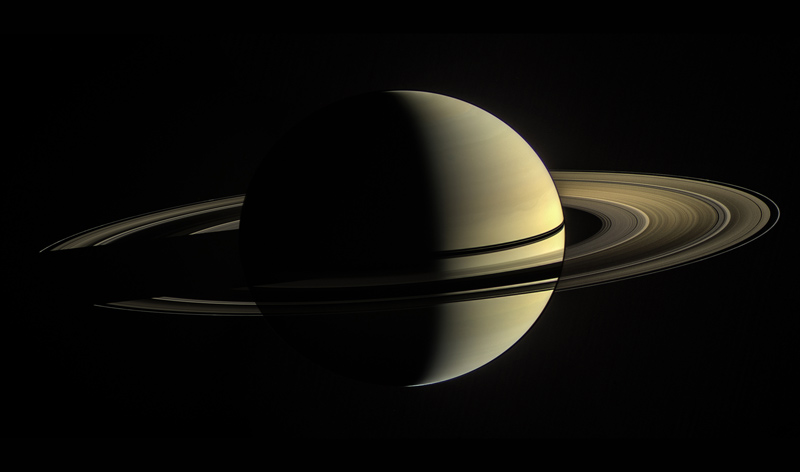Saturn

Orbital semi-major axis is 9.54 A.U. or 1427.0 million km.
Orbital eccentricity is 0.054.
Perihelion is 9.02 A.U. or 1349 million km.
Aphelion is 10.05 A.U. or 1504 million km.
Mean orbital speed is 9.65 km/s.
Sidereal orbital period is 29.42 tropical years.
Synodic orbital period is 378.09 solar days.
Orbital inclination to ecliptic is 24.49*.
Greatest angular diameter, as seen from Earth is 21″.
Mass is 5.681026 kg or 95.16 times that of Earth.
Equatorial radius is 60,268 km or 9.45 times that of Earth.
Mean density is 687 kg/m3 or 0.125 times that of Earth.
Surface gravity is 10.5 m/s2 or 1.07 times that of Earth.
Magnetic axis tilt relative to rotation axis 0.8*.
Surface temperature is approximately 97 k at its cloud tops.
number of moons: 18
The planets equatorial bands like those of Jupiter, but they are not as colorful as Jupiter’s nor do they exhibit the same great storm systems such as Jupiter’s great red spot.
Saturn’s atmosphere consists of 92.4 percent molecular hydrogen, 7.4 percent helium, 02 percent methane, and 0.02 percent ammonia.
The equatorial eastward jet stream can reach speeds of about 1500 km/h, compared to speeds of 400 km/h on Jupiter, while reaching much higher latitudes. In fact, it is not until the latitudes 40* north and south that first westward flows found. This latitude is also where we find the planets most obvious ovals and turbulent eddies.
The Pioneer and Voyager spacecraft both visited the planet in the 1970s.
Its internal structure is quite similar to that of Jupiter. Saturn’s metallic hydrogen layer is not thick, and the core is larger. Saturn’s core temperature, density, and pressure are less extreme, the central pressure being around a tenth of Jupiter’s, or similar to the pressure at the center of the Earth.
Like Jupiter the planet re-radiates more heat then it absorbs from the sun, but with Saturn this is because helium sinks toward the center the planet’s gravitational field, is compressed, and is subsequently heated up.
Magnetic field strength, as one would expect, is around 1/20 of Jupiter, or around 100 times that of Earth.
Although all Jovian planets are now known to have rings, Saturn’s are certainly one of the planets primary distinctions. The rings composition is mainly that of water ice particles moving together in circular orbits in a single plane. There is a point which tidal force stretching out a moon as it grows closer to a planet becomes greater than the internal forces holding it together, thus tearing the moon apart, and consequently dispersing its particles as rings. This point is referred to as the Roche Limit.
Titan is most notable of the planets moon and seems to have an atmosphere that is even thicker and denser than Earth’s. So interested are scientists in the moon that Voyager 1 was programmed to pass by it, forgoing further exploration to Uranus and Neptune. Its atmosphere is roughly 90 percent nitrogen and at most 10% argon, with a small percentage of methane.
Saturn was the outermost planet known to ancient astronomers. Its rings and moons were not discovered until after the invention of the telescope.
Saturn is smaller than Jupiter but is still much larger than any of the terrestrial worlds. Like Jupiter, Saturn rotates rapidly, producing a pronounced flattening, and displays differential rotation.
Strong radio emission from the planet’s magnetosphere allows the rotation rate of the interior to be determined.
Weather systems are seen on Saturn, as on Jupiter, although they are less distinct. Short-lived storms are occasionally seen.
Saturn has weaker gravity and a more extended atmosphere than Jupiter.
The planet’s overall butterscotch hue is due to cloud chemistry similar to that occurring in Jupiter’s atmosphere. Saturn, like Jupiter, has bands, ovals, and turbulent flow patterns powered by convective motion in the interior.
Like Jupiter, Saturn emits far more radiation into space than it receives from the Sun. Unlike Jupiter’s, Saturn’s excess energy emission is the result of helium precipitation in the planet’s interior, where helium liquefies and forms droplets, which then fall toward the center of the planet. This process is also responsible for Saturn’s observed helium deficit.
Saturn’s rings lie in the planet’s equatorial plane, so their appearance from Earth changes as Saturn orbits the Sun. The rings are made up of trillions of icy particles ranging in size from dust grains to boulders, all orbiting Saturn like so many tiny moons. Their total mass is comparable to that of a small moon. Both divisions are dark because they are almost empty of ring particles. When the Pioneer and Voyager probes reached Saturn, they found that the rings are actually made up of tens of thousands of narrow ringlets. Interactions between the ring particles and the planet’s inner moons are responsible for much of the fine structure observed in the main rings. The Roche limit of a planet is the distance within which the planet’s tidal field would overwhelm the internal gravity of an orbiting moon, tearing the moon apart and forming a ring. All known planetary ring systems lie inside their parent planets’ Roche limits.